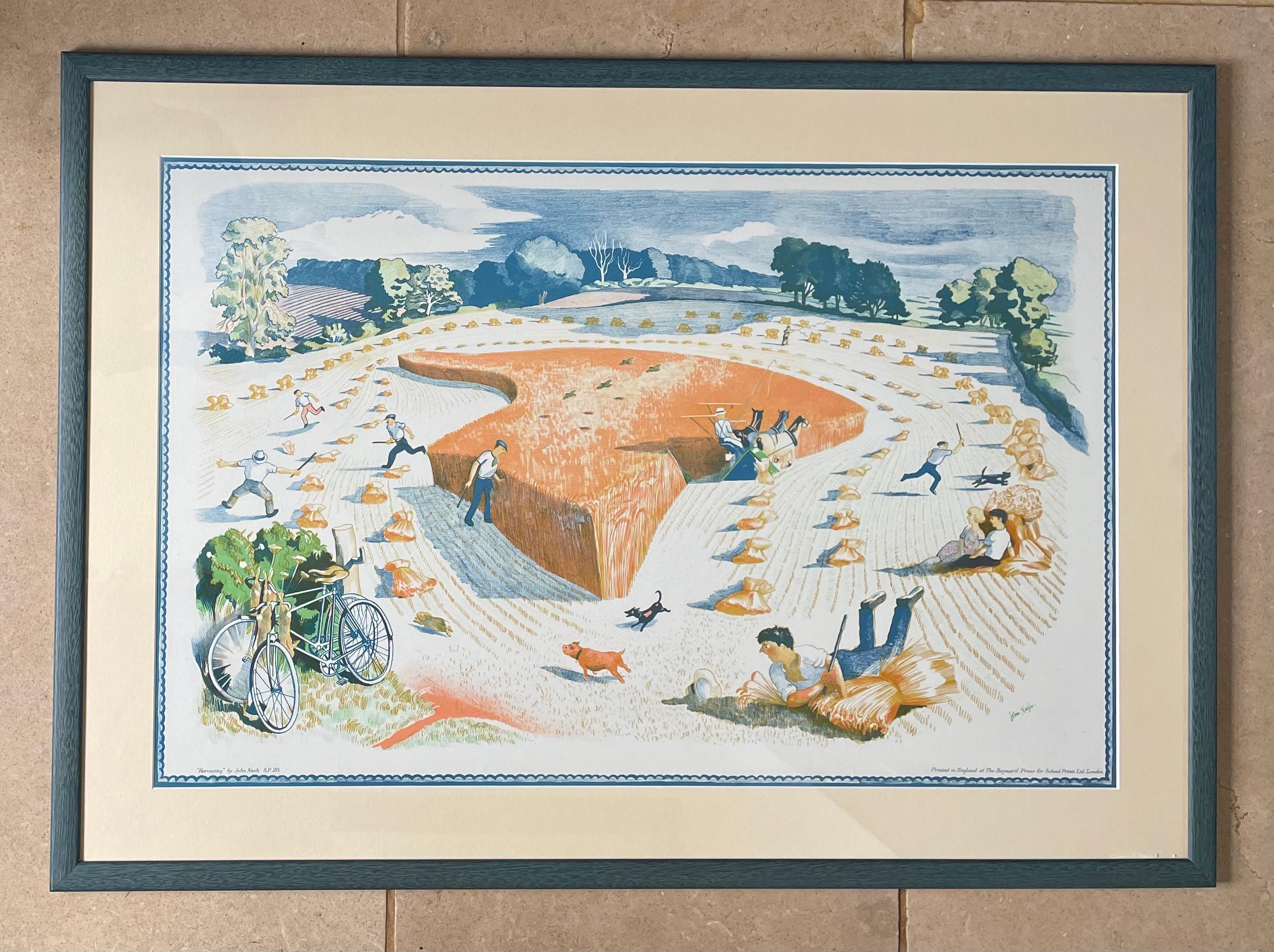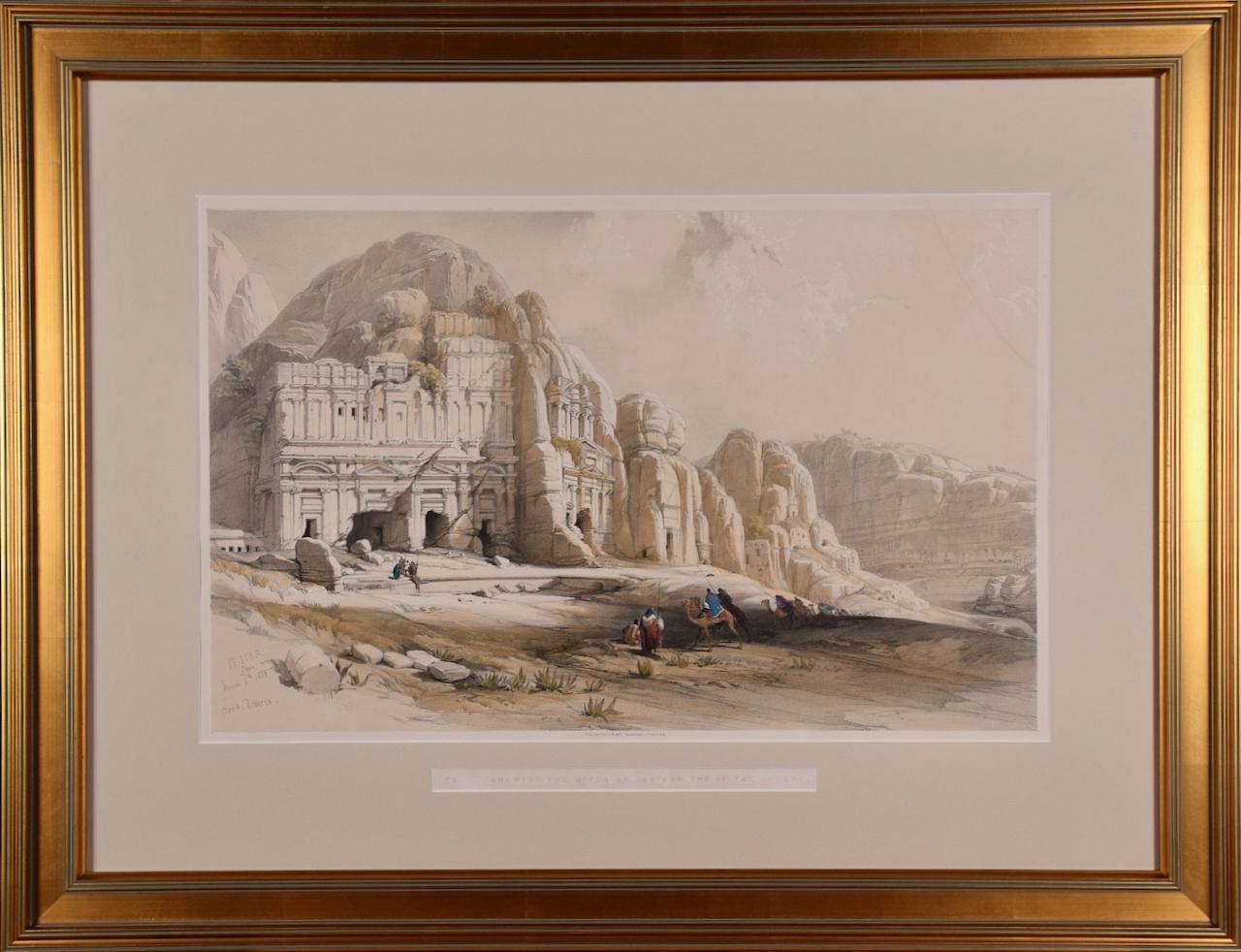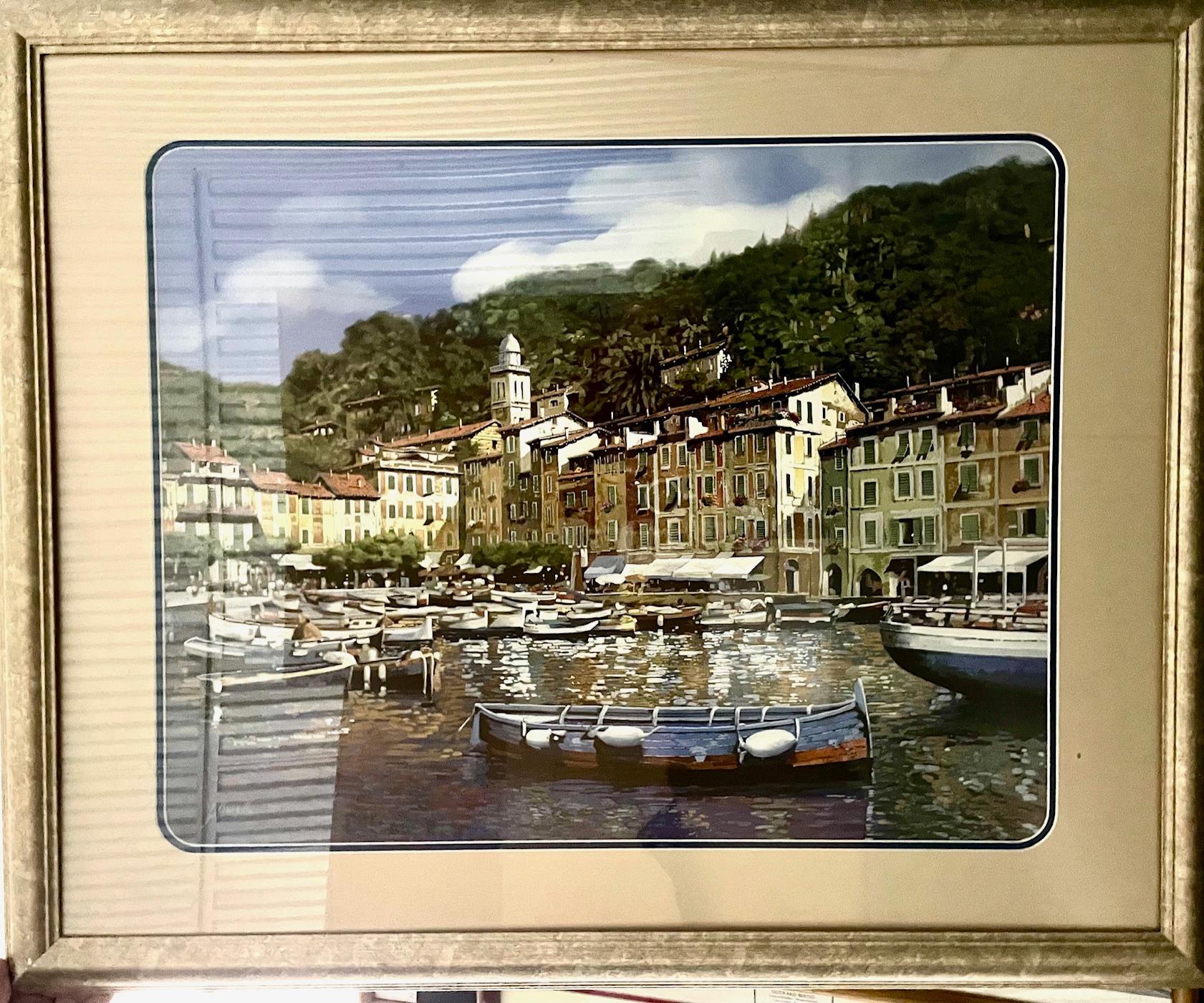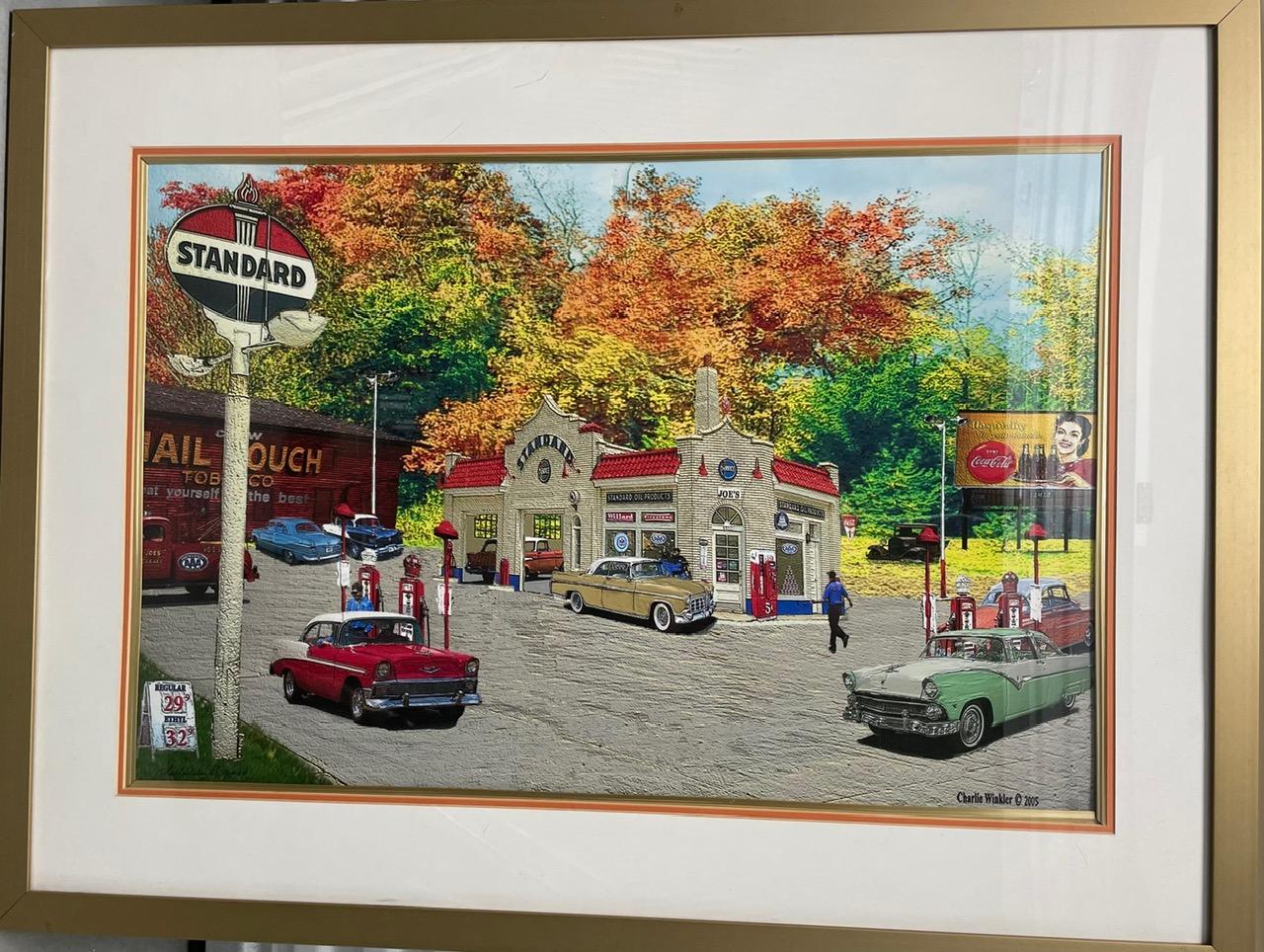Items Similar to David Roberts' Entrance to the Caves: A 19th Century Hand-colored Lithograph
Want more images or videos?
Request additional images or videos from the seller
1 of 8
David RobertsDavid Roberts' Entrance to the Caves: A 19th Century Hand-colored Lithograph1843
1843
About the Item
"Entrance To The Caves Of Beni Hasan" is a 19th century half-folio sized tinted duo-tone lithograph from the "The Holy Land, Syria, Idumea, Arabia, Egypt and Nubia" volume of David Roberts’ large folio edition, published in London by F. G. Moon in 1843. The lithographs were prepared by Louis Haghe (1806-1885) from drawings and paintings by Roberts. The resultant large folio editions of 'The Holy Land' and 'Egypt & Nubia' are considered the greatest lithographically illustrated works issued in the 19th century.
This half page duo-tone tinted lithograph depicts the entrance to the cave tombs at Beni Hasan. It is an Egyptian archaeological site on the eastern bank of the Nile approximately 155 miles south of Cairo. It dates from the Middle Kingdom (1938-1630 BCE). It is known for its 39 rock-cut tombs for 11th- and 12th-dynasty officials. Some of these tombs are adorned with painted scenes and hieroglyphic decriptions of daily life in ancient Egypt.In this scene, goats and people are seen in the foreground outside of the columned entrance.
This beautiful tinted duo-tone lithograph is presented in an attractive antiqued gold-color frame with double cream mats and glazed with museum quality archival materials. The frame measures 23.13" x 19.63" x 1.25". The print, frame and mat are in excellent condition. Two additional David Roberts' identically framed and matted lithographs of Egypt are available on 1stdibs, which would make a beautiful display grouping of two or three prints. Please see listings: LU117326087922 and LU117326087912. A discount is available for of two or three of these prints.
Artist: David Roberts (1796-1864) was born outside of Edinburgh, Scotland. At age 10 he became a house painter’s apprentice. He continued painting houses and eventually theater scenes in Edinburgh and then in London. His friend, J. M. W. Turner, recognized his artistic talent and encouraged him to become a full-time artist.
In 1839 he traveled to Egypt and then in 1840, through the Holy Land, concluding in Jerusalem. Upon his return to England, F. G. Moon agreed to publish lithographs created by Louis Haghe from Robert’s sketches and watercolors. This publication was highly acclaimed and very popular for its esthetic quality, its historical and topographical accuracy, and Robert’s dramatic depiction of his scenes. Queen Victoria and Charles Dickens were among the subscribers who collected his works. Robert’s and Haghe’s duotone lithographs, often colored, remain extremely sought-after today and have been rising steadily in value.
- Creator:David Roberts (1796-1864, British)
- Creation Year:1843
- Dimensions:Height: 23.13 in (58.76 cm)Width: 19.63 in (49.87 cm)Depth: 1.25 in (3.18 cm)
- Medium:
- Movement & Style:
- Period:
- Condition:
- Gallery Location:Alamo, CA
- Reference Number:
About the Seller
5.0
Platinum Seller
These expertly vetted sellers are 1stDibs' most experienced sellers and are rated highest by our customers.
Established in 2011
1stDibs seller since 2019
233 sales on 1stDibs
Typical response time: 1 hour
- ShippingRetrieving quote...Ships From: Alamo, CA
- Return PolicyA return for this item may be initiated within 7 days of delivery.
More From This SellerView All
- Approach of the Simoon, Desert of Gizeh: 19th C. Hand-colored Roberts LithographBy David RobertsLocated in Alamo, CAThis is an original 19th century hand-colored lithograph entitled "Approach of the Simoon, Desert of Gizeh" by David Roberts, from his Egypt and Nubia volumes of the large folio edition, published in London by F. G. Moon in 1849. The lithographs were prepared by Louis Haghe (1806-1885) from drawings and paintings by Roberts. The resultant large folio editions of 'The Holy Land' and 'Egypt & Nubia' are considered the greatest lithographically illustrated works issued in the 19th century. This is the most famous and collectible of David Roberts' works, entitled "Approach of the Simoon, Desert of Gizeh". The scene captures the dramatic moment when a fierce sandstorm, known as a simoon, approaches a caravan traveling through the desert of Gizeh in Egypt. The scene is filled with swirling clouds of sand, which obscure the figures of the travelers and their camels. The sky is dark and ominous, with lightning bolts striking the ground in the distance. The figures in the foreground appear to be huddling together for protection, while one man in the center struggles to keep his turban from being blown away. Roberts' lithograph is particularly striking for its attention to detail and its use of light and shadow to create a sense of depth and atmosphere. The figures and camels in the foreground are rendered with great precision, while the distant landscape and stormy sky are suggested with broad, sweeping strokes. Overall, "Approach of the Simoon, Desert of Gizeh" is a powerful and evocative image of the harsh realities of life in the desert, and a testament to David Roberts' skill as an artist. This is the most well known and sought-after of all Roberts prints, as well as the most difficult to find and hence most expensive. This hand-colored lithograph is printed on wove paper with wide margins. The print is in excellent condition. It is presented in a gold-colored wood frame with a tan mat. It is glazed with UV conservation glass. All framing materials used are archival museum quality. The frame measures 23.75" high and 29" wide. There are two additional iconic David Roberts hand-colored lithographs for sale on 1stdibs that are matted and framed in identical styles, although slightly different sizes. They are scenes of Petra and the Citadel of Cairo. They can be viewed by typing their reference #'s, LU1173211969422 and LU1173211970142, into the 1stdibs search field or typing Timeless Intaglio in the search field and tapping on the drop down name to be taken to our storefront. Two or all three of these pieces would make for a striking display grouping. A discount is available for the purchase of multiple pieces. David Roberts (1796-1864) was a Scottish painter who specialized in landscapes, architectural subjects, and scenes from the Middle East and Europe. Born in Edinburgh, Roberts began his career at age ten as an apprentice to a house painter and eventually became a scene painter for theater companies in Edinburgh and London. In the 1820s, J. M. W. Turner recognized his artistic talent and encouraged him to become a full-time artist. He began to focus on painting landscapes and architecture. In 1838 he traveled to Egypt and soon after to the Holy Land, concluding in Jerusalem. Roberts' travels in the Middle East had a profound impact on his art, and he produced a series of highly detailed and realistic paintings and sketches of the region's famous ruins and other landmarks, including the Pyramids of Giza, the Sphinx, the Temple of Abu Simbel...Category
Mid-19th Century Realist Landscape Prints
MaterialsLithograph
- Petra, The Upper or Eastern Valley: 19th C. Hand-colored Roberts LithographBy David RobertsLocated in Alamo, CAThis is an original 19th century hand-colored lithograph entitled "Petra, Shewing the Upper or Eastern End of the Valley" by David Roberts, from his Egypt, The Holy Land and Nubia volumes of the large folio edition, published in London by F. G. Moon in 1842. The lithographs were prepared by Louis Haghe (1806-1885) from drawings and paintings by Roberts. The resultant large folio editions of 'The Holy Land' and 'Egypt & Nubia' are considered the greatest lithographically illustrated works issued in the 19th century. This is one of Roberts' most famous and collectible works. The scene captures a view of the magnificent ruins of Petra in what is Jordan today, as it appeared on March 8, 1839, on the day of Roberts' visit. Multiple Arab men are approaching Petra; some on foot and others riding camels. They are dressed in their colorful local costumes. Roberts' signature and hand written date are reproduced in the plate on the left. This hand-colored lithograph is printed on wove paper with wide margins. There is some loss of color in the text in the title and a faint dark curvilinear area in the upper right. The print is otherwise in very good condition. It is presented in a gold-colored wood frame with a tan mat. It is glazed with UV protected conservation glass. All framing materials used are archival museum quality. The frame measures 23.5" high and 30.5" wide. There are two additional iconic David Roberts hand-colored lithographs for sale on 1stdibs that are matted and framed in identical styles, although slightly different sizes. They are scenes of Approach of Simoon, Desert of Gizeh and the Citadel of Cairo. They can be viewed by typing their reference #'s, LU1173211955452 and LU1173211970142, into the 1stdibs search field or typing Timeless Intaglio in the search field and tapping on the drop down name to be taken to our storefront. Two or all three of these pieces would make for a striking display grouping. A discount is available for the purchase of multiple pieces. David Roberts (1796-1864) was a Scottish painter who specialized in landscapes, architectural subjects, and scenes from the Middle East and Europe. Born in Edinburgh, Roberts began his career at age ten as an apprentice to a house painter and eventually became a scene painter for theater companies in Edinburgh and London. In the 1820s, J. M. W. Turner recognized his artistic talent and encouraged him to become a full-time artist. He began to focus on painting landscapes and architecture. In 1838 he traveled to Egypt and soon after to the Holy Land, concluding in Jerusalem. Roberts' travels in the Middle East had a profound impact on his art, and he produced a series of highly detailed and realistic paintings and sketches of the region's famous ruins and other landmarks, including the Pyramids of Giza, the Sphinx, the Temple of Abu Simbel...Category
Mid-19th Century Realist Landscape Prints
MaterialsLithograph
- David Roberts' 19th Century Duo-tone Lithograph, "Suez, General View"By David RobertsLocated in Alamo, CA"Suez, General View" is a 19th century folio sized tinted duo-tone lithograph, plate 124 from the "The Holy Land, Syria, Idumea, Arabia, Egypt and Nubia" volume of David Roberts’ large folio edition, published in London by F. G. Moon in 1843. The lithographs were prepared by Louis Haghe (1806-1885) from paintings by Roberts. The resultant large folio editions of 'The Holy Land' and 'Egypt & Nubia' are considered the greatest lithographically illustrated works issued in the 19th century. The lithograph depicts the Suez city skyline on a peninsula with boats moored in the bay. Men, dressed in traditional Arab costumes, rest on a hillside In the foreground with their camels, weapons and presumably goods for sale and trade. This tinted lithograph, which is professionally framed in a decorative gold-colored wood frame with cream-colored double mats. The print is in excellent condition. There are four additional listings of David Roberts hand colored engravings of Egypt...Category
1840s Realist Landscape Prints
MaterialsLithograph
- Thebes, Egypt: A Framed 19th Century Hand-colored Lithograph by David RobertsBy David RobertsLocated in Alamo, CA"Medinet Abou, Thebes" is a 19th century folio sized hand-colored lithograph from the Egypt and Nubia volume of David Roberts’ large folio edition, published in London by F. G. Moon ...Category
1840s Realist Landscape Prints
MaterialsLithograph
- A Pair of 19th C. Engravings Depicting the Costumes and Weapons of Afghani MenLocated in Alamo, CAThese hand-colored lithographs are from "Character and Costumes of Afghanistan", written by Lockyer Willis Hart (of the 22nd Bombay Native Infantry). The lithographs were created by ...Category
1840s Realist Portrait Prints
MaterialsLithograph
- David Roberts' 19th Century Duo-tone Lithograph: Colossus of the Temple of WadyBy David RobertsLocated in Alamo, CA"Colossus in Front of the Temple of Wady Saboua, Nubia" is a 19th century half-folio sized duo-tone lithograph from the "The Holy Land, Syria, Idumea, Arabia, Egypt and Nubia" volume of David Roberts’ large folio edition, published in London by F. G. Moon in 1843. The lithographs were prepared by Louis Haghe (1806-1885) from drawings and paintings by Roberts. The resultant large folio editions of 'The Holy Land' and 'Egypt & Nubia' are considered by many to be the most beautiful lithographically illustrated works issued in the 19th century. This half page lithograph depicts two colossal statues that stood in front of Temple of Wady in Nubia, each measuring 14 feet high and 5 feet across at the shoulders. Both figures hold a long staff with a symbolic rams head and disc on top. The second colossus lies on the ground. Three guards are in conversation with two other individuals at the base of the upright statue. Nubia is the area between Aswan in southern Egypt and Khartoum in central Sudan. It was the site of one of the earliest civilizations of ancient Africa...Category
1840s Realist Landscape Prints
MaterialsLithograph
You May Also Like
- John Nash RA - Harvesting - Schools Print - 20th Century British lithographBy John NashLocated in London, GBJOHN NASH, RA (1893-1977) Harvesting Lithograph Framed 49 by 75 cm., 19 ¼ by 29 ½ in. (frame size 65 by 91.5 cm., 25 ½ by 35 ½ in.) On the advice of his older brother, the artist...Category
Mid-20th Century Realist Landscape Prints
MaterialsLithograph
- Two Heads by Henry Moore abstract black and white figure portrait AudenBy Henry MooreLocated in New York, NYOne of a series of 18 lithographs drawn by the artist for the Auden Poems/Moore Lithographs 1974 book and portfolio. This work is from an edition of 25 printed on vellum aside from t...Category
Late 20th Century Realist Abstract Prints
MaterialsLithograph
- PortofinoBy Guido BorelliniLocated in Clinton Township, MIA busy harbor is the subject of this painting by Borelli. This serigraph is both plate signed as well as signed by the artist.Category
Mid-20th Century Realist Landscape Prints
MaterialsLithograph
- The Standard StationLocated in Clinton Township, MIAmericana is the subject of most of Michigan native Charlie Winkler's photography. He was adept at photoshop and would add any particular car the buyer wished! (This may be the Stan...Category
Late 20th Century Realist Landscape Prints
MaterialsLithograph
- White River Light by Leo KuschelLocated in Clinton Township, MIMIchigan's White River is the location of this limited edition lithograph signed and remarqued by Michigan artist Leo Kuschel. It is numbered 124/250 and is also framed.Category
Late 20th Century Realist Landscape Prints
MaterialsLithograph
- Neil Welliver at O'Farrel Gallery posterBy Neil WelliverLocated in New York, NYNeil Welliver at O'Farrel Gallery poster, 1998 Offset lithograph 24 × 18 inches Unframed This offset lithograph poster was published on the occasion of Neil Welliver's exhibition at O'Farrell Gallery from July 17 to September 5, 1998. The depicted painting on the poster is Neil Welliver, Marsh Shadow, 1986. Publisher O'Farrell Gallery, Brunswick, Maine About Neil Welliver: Neil Welliver (American, 1929-2005) is best known for his large-scale, vivid paintings and woodcuts of the remote Maine wilderness. Born in the small town of Millville, Pennsylvania, he first studied at the Philadelphia College of Art (1953), followed by Yale (1955), where Josef Albers and Burgoyne Diller were among his teachers. Their influence, as well as the rising popularity of Abstract Expressionism, is evident from Welliver’s early experimentations in abstraction, which include elements of color field painting, as well as the color theory of Albers, and the flattened, “allover” space of Pollock and de Kooning. Welliver would go on to teach at Yale from the mid-1950s to the mid-1960s, by which time he had moved formally towards the representational, beginning to paint the landscape of Maine. In the late 1960s and early 70s he also produced scenes of nude bathers in streams, their bodies abstracted by the moving water. While continuing to work as the chair of the University of Pennsylvania graduate school (1966-1989), he moved permanently to Lincolnville, Maine, in 1970. Welliver lost his studio, home, and much of his work to a fire in 1975. The following year, his second wife and infant daughter died. Further tragedy came with the death of his college aged son in 1991. His artistic practice remained the mode through which he survived these hardships. By the 1980s he was painting landscapes almost exclusively. The resulting body of work nods to many of Welliver’s early influences, as he utilizes natural repetitions and distortions to represent the innate abstraction of the natural world. These mature works are based on long plein-air studies, where Welliver would carry a 70-pound pack of painting supplies into remote landscapes, and sit for three hours at a time. He continued to paint the landscape surrounding his large property in Maine until his death in 2005. Welliver was a member of the National Academy of Design, and received notable awards from the Guggenheim Foundation and the Skowhegan School of Painting and Sculpture. His work is in the collections of the Museum of Modern Art, New York; the Metropolitan Museum of Art, New York; and the Museum of Fine Arts, Boston, among others. - Courtesy of Alexandre GalleryCategory
1990s Realist Landscape Prints
MaterialsLithograph, Offset
Recently Viewed
View AllMore Ways To Browse
Please Return To
Davids Antiques
David Antiques
Antique Entrance
Antique Edinburgh Scotland
Antique Cave
Egyptian Display
London 19th Century Lithograph
Goat Print
Print Groupings
David Roberts Lithograph
David Roberts Lithographs
Scottish Lithograph
Lithograph Scotland
Lithograph Egypt
Large Egyptian Print
Arabian Prints
Egyptian Tomb





